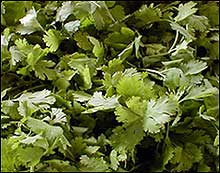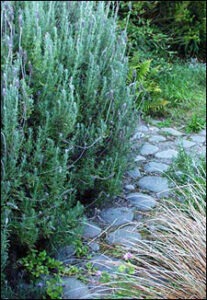Blog and Recipes
Herb Gardening
Good Bedfellows… Bad Bedfellows
| Several herbs are believed to have positive effects when they are planted near vegetables or other herbs. They not only protect them from insects but are believed to boost their growth and improve their flavor. Chives, for instance, promote the growth of carrots; parsley or borage help tomatoes. Rosemary and sage thrive when planted in tandem, and yarrow is thought to increase the fragrance of most herbs. However, some plants decline because they cannot tolerate the particular chemistry of their companions. Basil, for example, hinders rue. Coriander retards the growth of fennel, tomatoes and beans. | |
| Careful planning is the key to companion planting. Place good bedfellows close together. Use paths and walkways to separate foes. Alternate complimentary herbs and plants in rows, locating them checkerboard -style in a bed. Or plant protective herb borders around pest-susceptible vegetables and ornamentals. The most interesting aspect of companion planting is the cumulative benefit. When herbs, vegetables and flowers are grown together, food plants seem to be more flavorful, flowers and scented leaves become more fragrant. All the while the combinations and interactions help control pests. | |
| Herb | Vegetable |
| Anise | Coriander |
| Basil | Peppers, Tomatoes |
| Bee Balm | Tomatoes |
| Borage | Beans, strawberries |
| Chamomile | Cucumbers, onions |
| Chervil | Radishes |
| Dill | Cabbages, lettuces |
| Galic | Roses |
| Horseradish | Potatoes |
| Hyssop | Cabbages, grapes |
| Lovage | Beans |
| Mint | Cabbages, Tomatoes |
| Mustards | Grapes, fruit trees, beets |
| Oregano | Beans |
| Rosemary | Tomatoes Marjoram |
| Savory | Beans, onions |
| Tarragon | Most Vegetables |
| Thyme | Eggplant, potatoes |
Blog and Recipes
Older Blog Posts
For older blog posts please visit http://bloomtoscoop.blogspot.com/.
Blog and Recipes
Rosemary
| According to custom, rosemary twined in your hair stimulated the memory or helped prevent baldness, depending upon your need. Also connoting friendship, no more party favor could be offered than a gilded rosemary sprig.Rosemary flourished through medieval and renaissance periods. Every garden seemed to have a single bush or several, often pruned in fanciful or symmetrical shapes. The essential oil or the leaves and flowers were used as a bath freshener and mouthwash, in liniments and as a moth repellent.Rosemary has been grown in gardens for so long that natural hybrids have occurred, resulting in forms suitable for many landscape situations.
Rosmarinus officinalis has an upright, shrublike growth habit, reaching 3 to 6 feet high and as wide. Plants blend well with many gray-foliaged plants found in the herb garden. R. officinalis ‘Prostratus’ is the ground-hugging form, more commonly grown in mild-winter regions of the West. It performs well as a cascading ground cover draped over a wall, on slopes or in the foreground of a flowerbed. The gray-green leaves create a dense, 2 foot-high plant that can spread 4 to 6 feet in diameter. Leaves of all forms are needlelike with decurved edges and whitish undersides. Flowers come in shades of blue to white. They nestle in the axils of clustered leaves on younger stems and cove the aromatic foliage from late winter to early spring. They are highly attractive to bees. Planting and CarePlant from containers in early spring or in fall in mild-winter areas. Accepts almost any well-drained soil. Plant in full-sun to partial-shade. Water needs are low to moderate, once plants are established. Over-watering and too much fertilizer cause growth to be rank. To maintain a low, flowing form, cut back to hard wood, reducing foliage buildup in center of plant. Prune to maintain natural plant form every year of two in late winter, prior to the strong, surge of early spring growth. In cold winter regions, rosemary cannot survive as a landscape plant, but it can be grown using the indoors-to-outdoors method. When growing in pots use a mixture of perlite, or large-grained, sterile sand, humus and potting soil for good drainage and aeration. Grow indoors in a sunny location. Accepts low water but performs best with regular irrigation. Reduced sunlight and lower daytime temperatures indoors lessen the need for water. Harvesting and UseRosemary’s components of tannin and camphor give it a moderate bitterness and pepperiness, especially with foods in high fat, like lamb roasts and pork or with bland foods such as potatoes or legumes. Dried rosemary generally can be substituted for fresh. Whole needles must be dried to preserve its oils. Tie in a cheesecloth bag or mince well before adding to foods so you won’t chew on the tough needles. The flavor strength of the dried herb varies greatly, but usually one part dried herb equals about four parts fresh. We use rosemary in all kinds of body care products, fragrances, and in savory foods and even our famous, Rosemary-Orange Rum Cake. |


